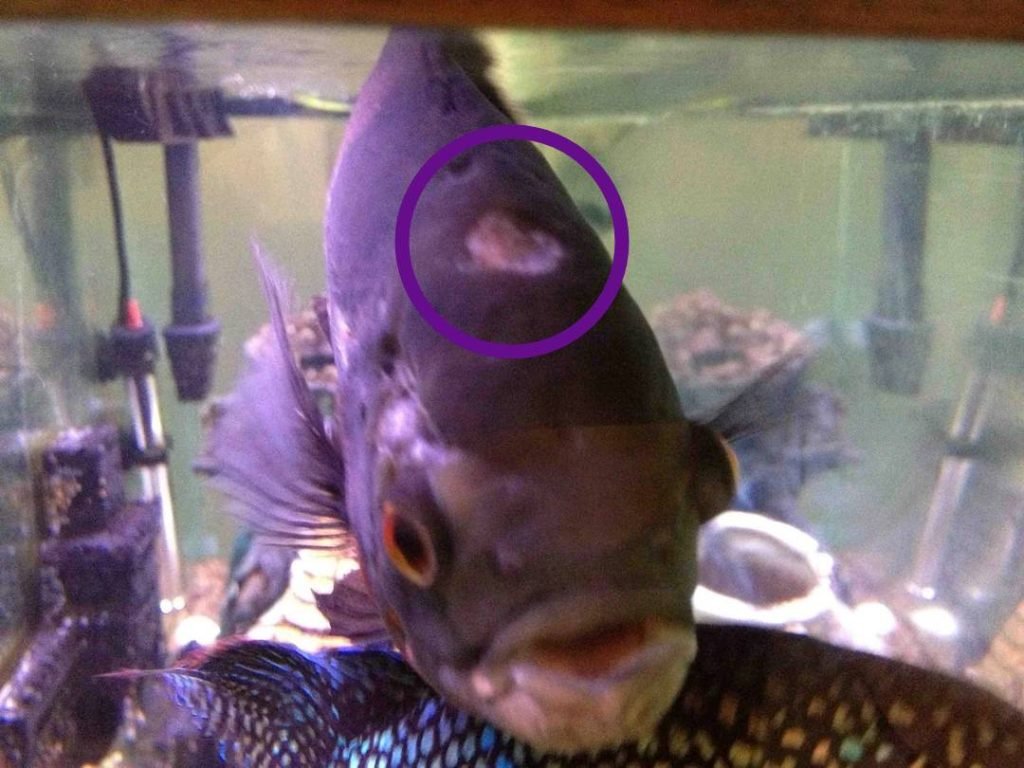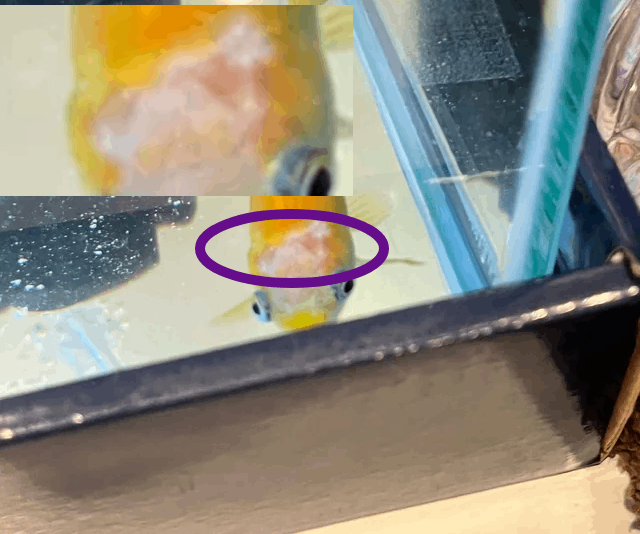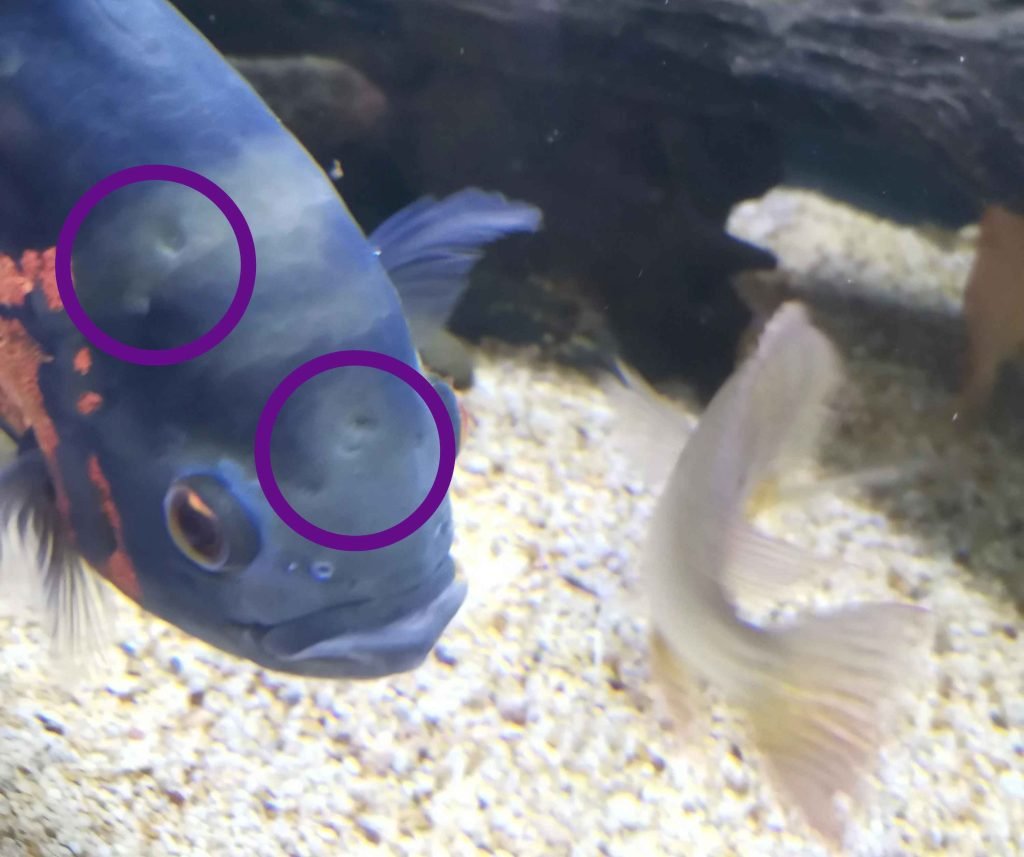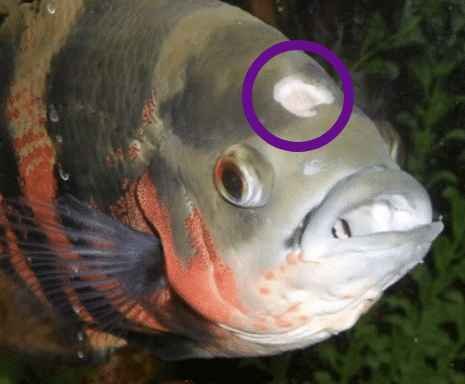Hexamitiasis Guppy: The Care Your Guppy Needs Now
How I deal with hole in the disease in guppies

I'm well aware this is, indeed, not a guppy.
So you have a sick guppy.
Maybe it’s swimming strangely, but most likely you’ve noticed a big dent around its head.
So how do you fix it, and what can you do to prevent the next one?
I’ll walk you through how I treat guppy hole in the head disease, which is also called guppy Hexamitiasis (catchy name, I know).
TL;DR Version
How To Treat Guppy Hexamitiasis
What Causes Guppy Hexamitiasis
A parasitic infection is to blame, but the culprit is usually dirty water conditions and a poor diet. It can be either one or a combination of both.
How To Identify Guppy Hole In The Head
The biggest sign will be a hole appearing on the fish’s head. Other symptoms can come to light as a loss of appetite, decreased activity and increased hiding, duller colors, and white or stringy poop.
How To Treat Guppy Hexamitiasis
Remove the infected fish from the tank. Treat the fish with Epsom salt at 1 tsp of salt for every 10 gallons of water, or with metronidazole (Flagyl) as the label instructs.
Then clean the original tank, making sure no waste is at the bottom, and check to make sure your filter works properly. You want to make sure your guppies are getting the proper nutrition too.
Guppy Hexamitiasis Symptoms
If you think your guppy may have Hexamitiasis, look for the following symptoms:
- Loss of appetite and weight loss.
- Lethargy and decreased activity levels.
- Stringy or white feces.
- Visible lesions or holes on the fish’s head or body.
- Dull coloration or fading of the guppy’s vibrant appearance.
- Hiding or isolating behavior.
Hexamitiasis Pictures



What Causes Guppy Hexamitiasis
If it makes you feel better- this is a common parasitic disease that can affect guppy fish.
Let’s move forward to find out what is out of place in your tank that allowed the parasite to grow strong.
Poor Water Quality
One of the main reasons for hexamitiasis to develop is your tank water.
- Do you have high levels of ammonia, nitrite, or nitrate?
- Is the tank low on oxygen? (guppies in the corner of the tank is a sign of it)
- Is your filter working properly?
Those all play a part in keeping your guppies healthy.
Stress
Stressful conditions make guppy diseases spread like wildfire.
We’re talking about:
- Sudden changes in water parameters (over 1 degree change in 24 hours)
- Overcrowding (more than 6 guppies per 10 gallons)
- The wrong temperature (78-82 is the ideal, anything outside of it you’re exposed to disease)
Contaminated Tank Mates or Live Food
Out of all the things you can control, this one is probably the one you can control the least.
There’s a theory that 80% of fish tanks have at least a disease living in them.
What you can do to protect your guppies is to quarantine new fish and to only buy from reputable sources (like your local fish store)
Poor Nutrition
There are a lot of things that guppies can eat.
The safest bet is to feed them commercial flake or pellet food formulated for tropical fish. Feed them 2-3 times a day.
Weakened or Injured Fish
Fish that are already weakened or have existing health issues, such as injuries or other infections, are more vulnerable to hexamitiasis.
The parasite can take advantage of the compromised immune system and infect the fish more easily.
Guppy hole in the head in most common in stressed or immunocompromised guppies.
Healthy fish with proper tank conditions and good nutrition are less likely to experience hexamitiasis outbreaks.
Is Hexamitiasis Deadly To Guppies?
Hexamitiasis can be a serious and potentially deadly condition in guppies if left untreated. How bad it is will depend on how long it’s been harboring.
In some cases your guppy’s health can take a nose dive and it’s condition can worsen very fast- leading to death.
With that in mind, as long as you’re able to catch it in time- you will be able to heal it in most cases.
How To Treat Guppy Hexamitiasis
Step 1: Quarantine
First things first, isolate any affected guppies in a separate quarantine tank.
This will help prevent the spread of the parasite to your other fish and ensure that the quarantine tank has clean, dechlorinated water and good aeration.
Step 2: Medication - Metronidazole
Metronidazole is my go-to treatment for hexamitiasis. You can find this medication at most pet stores or online. Follow the instructions on the product carefully. Generally, you’ll need to mix the medication with your guppies’ food.
Here’s an example of how to apply it:
- Crush some high-quality guppy flakes into a fine powder.
- Mix the recommended amount of Metronidazole (according to the product label) with the powdered food.
- Add a small amount of tank water to create a paste-like consistency.
- Feed this mixture to your quarantined guppies for several days, ensuring they eat it.
Step 3: Water Quality
Maintaining good water quality is crucial for your guppies’ recovery.
Regular water changes, about 20% every few days, will help remove any waste or medication residues from the quarantine tank.
Step 4: Supportive Care
During their recovery, it’s essential to provide your guppies with a low-stress environment. Keep the water temperature stable (around 78-82°F and dim the lighting in the quarantine tank.
You can add aquarium salt at a rate of 1 tsp for every 10 gallons of water to support your guppies immune system.
Step 5: Observation and Patience
Now comes the waiting game. Keep a close eye on your quarantined guppies. Over time, you should notice improvements in their appetite and behavior.
Treatment duration may vary, but continue feeding them the medicated food for at least a week, even if they seem better.
How The Hexamitiasis Parasite Slips Into Your Guppy Tank
Protozoan parasites can enter a guppy tank through various means. Here are some common ways in which a protozoan parasite can find its way into a guppy tank:
Hexamitiasis Infected Fish
Parasites usually hide in the guppies’ stomachs before they find their way into the tank. It may not affect the original fish, but gain access to the whole tank when the host poops.
You’ll need to quarantine your fish, and hopefully your decoration, before introducing them into the tank.
Contaminated Water
This one is easy to fix- just use a water conditioner or a dechlorinator when changing or topping up water.
Contaminated Equipment or Decorations
Protozoan parasites can also be introduced into the tank through contaminated equipment or decorations. If nets, siphons, or other aquarium equipment used in another tank with infected fish are not properly cleaned and sanitized, they can transfer parasites to the guppy tank.
Similarly, plants, rocks, or other decorations collected from natural sources without adequate cleaning can harbor protozoan cysts or parasites.
6 Steps to Prevent Hexamitiasis In Guppies
To prevent Hexamitiasis in your guppy tank, it’s important to follow these guidelines:
Quarantine New Fish
Before introducing new fish into your guppy tank, quarantine them in a separate tank for a minimum of two weeks.
Monitor their health closely during this period to ensure they are free from any signs of infection.
Maintain Optimal Water Quality
Regularly test and maintain proper water parameters in the tank. Keep ammonia, nitrite, and nitrate levels in check, and ensure adequate oxygenation.
Perform regular water changes to remove any accumulated toxins or waste.
Practice Good Hygiene
Maintain good hygiene practices in your tank. Clean and disinfect any equipment, such as nets, siphons, or decorations, before transferring them between tanks.
This reduces the risk of cross-contamination and minimizes the spread of parasites.
Provide a Balanced Diet
Offer your guppies a balanced and nutritious diet to support their immune system and overall health.
High-quality commercial fish foods formulated specifically for guppies often contain essential nutrients, including vitamins and minerals, to enhance their immune response.
Additionally, provide a variety of live or frozen foods, such as brine shrimp or daphnia, to ensure a diverse nutrient intake.
Avoid Overcrowding
Keep your guppy tank properly stocked and avoid overcrowding. Overcrowding can create stressful conditions, weaken the immune system of the fish, and increase the likelihood of disease outbreaks, including Hexamitiasis.
Maintain an appropriate number of guppies based on the tank size and filtration capacity.
Monitor Your Guppies' Health
Regularly observe your guppies for any signs of illness or abnormal behavior. Look for symptoms such as loss of appetite, lethargy, fin clamping, or unusual swimming patterns.
If you notice any abnormalities, promptly address the issue by isolating affected fish and seeking advice from a veterinarian or experienced fish hobbyist.
Conclusion
We’ve covered quite a bit in this article. Let’s recap:
The reason your guppy gets this disease is because of a parasite. The prevent the next case, quarantine any new additions for at least 4 weeks. The better you keep the water, the more immune your fish will be to the parasite.
To tackle the parasite you’d use a medication called Metronidazole.
I hope your guppy makes a full recovery.
P.S.
Will you do me a personal favor and leave me a comment below to let me know how your fish is doing?
